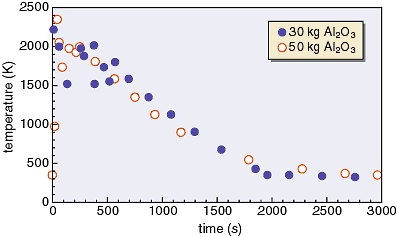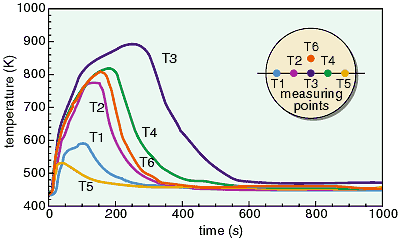 |
|||||
|
|||||
@
 |
|||||
|
|||||
 |
|||||
|
|||||
| JAERI has promoted the so-called Assessment of Loads and Performance
of containment of Hypothetical Accident (ALPHA) program to evaluate
the integrity of a reactor pressure vessel and its containment
under severe accident conditions. The following is recent, useful
data on debris coolability obtained in large-scale experiments
of the program. During a severe accident, the reactor core is molten, and falls through the water and accumulates on the lower head of the pressure vessel. Figure 6-4 shows the large equipment for simulating such phenomena. The core melt is called debris and is simulated here by molten Al2O3 produced by the exothermic reaction between aluminum and iron oxide (thermit reaction). Figure 6-5 shows that the debris simulants (about 30 and 50 kg) poured into the experimental vessel are cooled similarly from the initial temperature, about 2,700 K, although there is a difference of a factor of about two in volume (weight). In the case of the 50 kg debris simulant, the outer wall of the vessel was rapidly cooled (Fig. 6-6), while the simulant still kept a high temperature of about 2,000 K (Fig. 6-5). This observation implies that an interfacial gap was formed between the simulant and the vessel wall which allowed water to penetrate, causing an effective cooling of the lower head experimental vessel. The ultrasonic technique applied after the cooling experiment confirmed the existence of a gap ranging from 1 to 2 mm. This information is important because of the implication that a reactor pressure vessel keeps its integrity in the presence of water during a severe accident. |
| Reference Y. Maruyama et al., Studies on In-Vessel Debris Coolability in ALPHA Program, NUREG/CP-0517 (2), 161 (1997). |
| Select a topic in left column |
|
Persistent Quest-Research Activities 1998 Copyright(c)Japan Atomic Energy Research Institute |